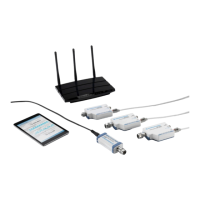Remote control commands
R&S
®
NRPxxS(N)
109User Manual 1177.5079.02 ─ 15
Parameters:
<state> *RST: OFF
Manual operation: See "Duty Cycle" on page 46
9.8.4.2 Offset corrections
The offset accounts for external losses by adding a fixed level offset in dB.
The attenuation of an attenuator located ahead of the sensor (or the coupling attenua-
tion of a directional coupler) is considered with a positive offset. That means the power
sensor calculates the power at the input of the attenuator or the directional coupler. A
negative offset can be used to correct the influence of an amplifier connected ahead.
Using S-parameters instead of a fixed offset allows more precise measurements,
because the interaction between the power sensor and the component can be consid-
ered. See also Chapter 9.8.4.3, "S-parameter correction", on page 109.
Remote commands:
[SENSe<Sensor>:]CORRection:OFFSet.......................................................................... 109
[SENSe<Sensor>:]CORRection:OFFSet:STATe................................................................ 109
[SENSe<Sensor>:]CORRection:OFFSet <offset>
Sets a fixed offset that is added to correct the measured value.
Parameters:
<offset> Range: -200.00 to 200.00
*RST: 0
Default unit: dB
Manual operation: See "<Value>" on page 45
[SENSe<Sensor>:]CORRection:OFFSet:STATe <state>
Enables or disables the offset correction.
Parameters:
<state> *RST: OFF
Example:
CORR:OFFS:STAT ON
Manual operation: See "<State>" on page 44
9.8.4.3 S-parameter correction
S-parameter correction compensates for the losses and reflections introduced by a
component — such as an attenuator, directional coupler, or matching pad — that is
attached to a power sensor. Using S-parameters instead of a fixed offset increases
measurement accuracy by accounting for the interaction between the power sensor
and the component. It shifts the reference plane of the power sensor from its RF con-
nector to the input of the device that is being applied externally.
Configuring basic measurement parameters

